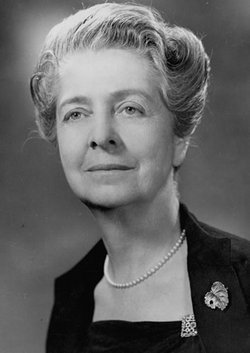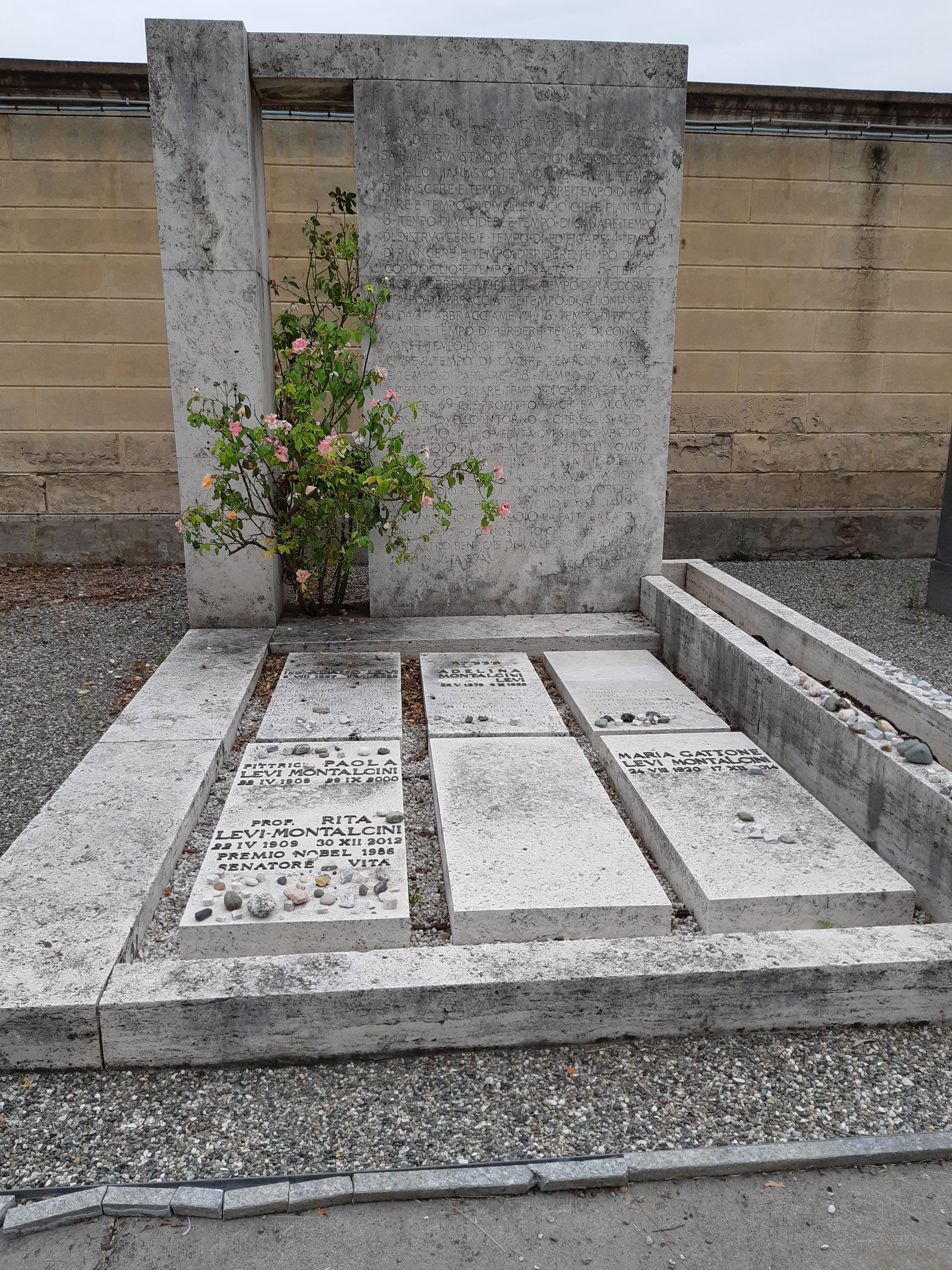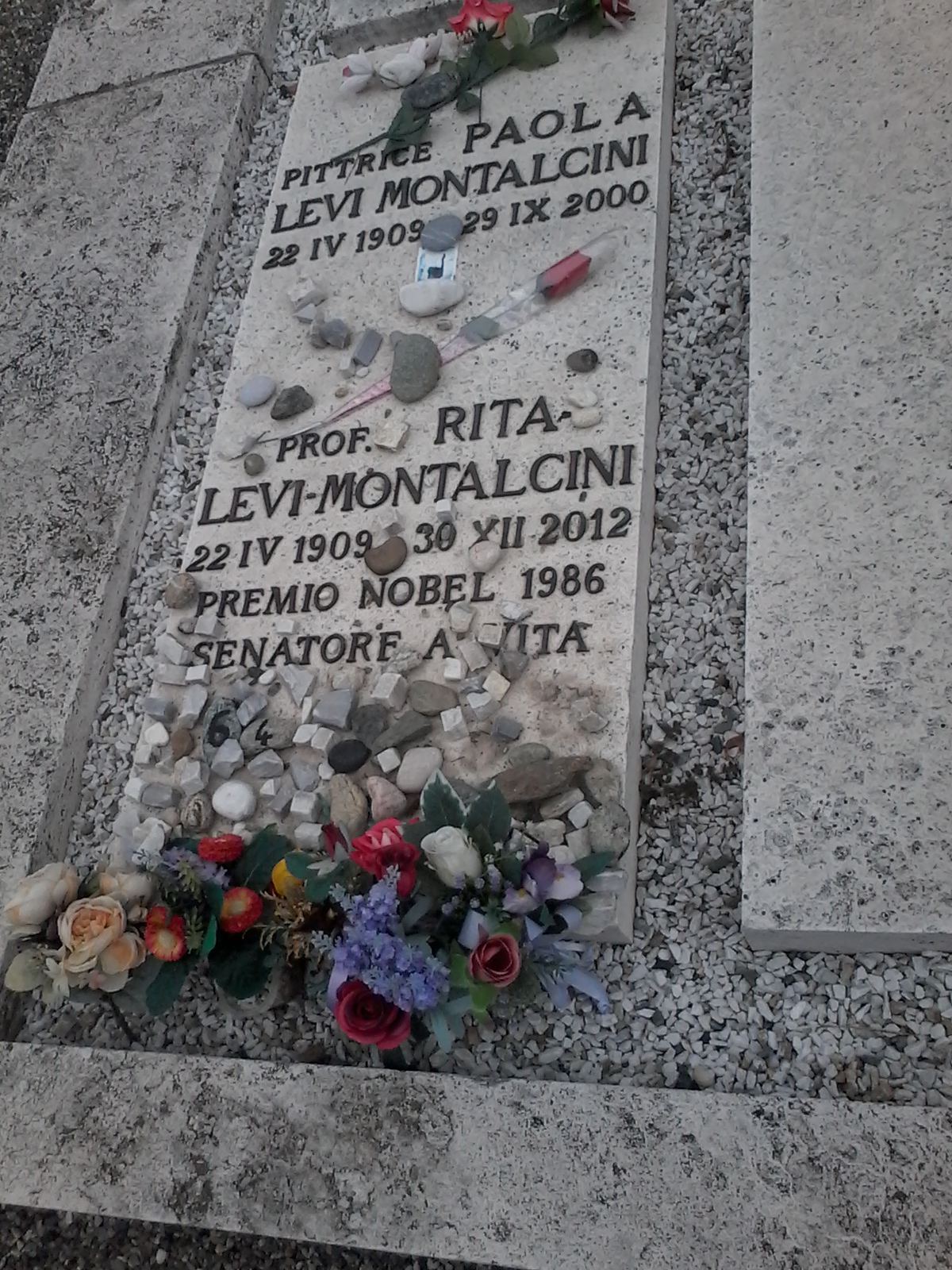Scientist, Physician. Nobel Prize Winner in Physiology. She conducted experiments from a home laboratory, studying the growth of nerve fibers in chicken embryos, which laid the groundwork for much of her later research. (She described this experience decades later in the science documentary film Death by Design/The Life and Times of Life and Times (1997), which also features her identical twin sister Paola, who had entered a decades-long career in the arts.) Her first genetics laboratory was in her bedroom at her home. In 1943, her family fled south to Florence, and she set up a laboratory there also. During this time she also volunteered her medical expertise for the Allied health service. Her family returned to Turin in 1945. In September 1946, she accepted an invitation to Washington University in St. Louis, under the supervision of Professor Viktor Hamburger. Although the initial invitation was for one semester, after she repeated the exciting results from her home laboratory, Hamburger offered her a research associate position. She stayed in St. Louis for thirty years. It was there that she did her most important work: isolating the nerve growth factor (NGF) from observations of certain cancerous tissues that cause extremely rapid growth of nerve cells in 1952. By transferring pieces of tumors to chick embryos, Montalcini established a mass of cells that was full of nerve fibers. This discovery, of nerves growing everywhere like a halo around the tumor cells, was surprising. Montalcini described this "like rivulets of water flowing steadily over a bed of stones." The nerve growth produced by the tumor was unlike anything she had seen before - the nerves took over areas that would become other tissues and even entered veins in the embryo! But, importantly, nerves did not grow into the arteries, which would flow from the embryo back to the tumor. This suggested to Montalcini that the tumor itself was releasing a substance that was stimulating the growth of nerves. She was made a Full Professor in 1958, and in 1962, established a research unit in Rome, dividing the rest of her time between there and St. Louis. From 1961 to 1969 she directed the Research Center of Neurobiology of the CNR (Rome), and from 1969 to 1978 the Laboratory of Cellular Biology. She founded the European Brain Research Institute in 2002, and then served as its president. Her role in this institute was at the center of some criticism from some parts of the scientific community in 2010. Controversies were raised about the cooperation of Levi-Montalcini with the Italian pharmaceutical industry Fidia. While working for Fidia, she improved the understanding of gangliosides. Beginning in 1975, the scientist supported the drug Cronassial (a particular ganglioside) produced by Fidia from bovine brain tissue. Independent studies showed that the drug actually could be successful in treatment of intended diseases (periphrastic nervous system neuropathies). Years later, some patients under treatment with Cronassial reported a severe neurological syndrome (Guillain-Barré syndrome). As per the normal cautionary routine, Germany banned Cronassial in 1983, followed by other countries. Italy prohibited the drug only in 1993; at the same time, an investigation revealed that Fidia paid the Italian Ministry of Health for a quick approval of Cronassial and later paid for pushing use of the drug in treatment of diseases where it had not been tested. During the investigation, one of the witnesses spoke about the use of Levi-Montalcini as a sponsor for the drug, even suggesting that the Nobel prize could have been "sponsored", and serious criticism was levied at Levi-Montalcini. In the 1990s, she was one of the first scientists pointing out the importance of the mast cell in human pathology. In the same period (1993) she identified the endogenous compound palmitoylethanolamide as an important modulator of this cell. This line of research led to using this endogenous compound as an analgesic and anti-inflammatory drug. On 1 August 2001, she was appointed as Senator for Life by the then President of the Italian Republic, Carlo Azeglio Ciampi. On 28–29 April 2006, Levi-Montalcini, aged 97, attended the opening assembly of the newly-elected Senate, at which the President of the Senate was elected. She declared her preference for the centre-left candidate Franco Marini. Due to her support of the government of Romano Prodi, she was often criticized by some right-wing senators, who accused her of "saving" the government when the government's exiguous majority in the Senate was at risk. She was insulted by neo-fascist politicians such as Francesco Storace. On 17 January 2010, she was present in Rome's main synagogue, during the official visit of Pope Benedict XVI. She is featured on the 2024 Italian Commemorative 2 Euro Coin.
Scientist, Physician. Nobel Prize Winner in Physiology. She conducted experiments from a home laboratory, studying the growth of nerve fibers in chicken embryos, which laid the groundwork for much of her later research. (She described this experience decades later in the science documentary film Death by Design/The Life and Times of Life and Times (1997), which also features her identical twin sister Paola, who had entered a decades-long career in the arts.) Her first genetics laboratory was in her bedroom at her home. In 1943, her family fled south to Florence, and she set up a laboratory there also. During this time she also volunteered her medical expertise for the Allied health service. Her family returned to Turin in 1945. In September 1946, she accepted an invitation to Washington University in St. Louis, under the supervision of Professor Viktor Hamburger. Although the initial invitation was for one semester, after she repeated the exciting results from her home laboratory, Hamburger offered her a research associate position. She stayed in St. Louis for thirty years. It was there that she did her most important work: isolating the nerve growth factor (NGF) from observations of certain cancerous tissues that cause extremely rapid growth of nerve cells in 1952. By transferring pieces of tumors to chick embryos, Montalcini established a mass of cells that was full of nerve fibers. This discovery, of nerves growing everywhere like a halo around the tumor cells, was surprising. Montalcini described this "like rivulets of water flowing steadily over a bed of stones." The nerve growth produced by the tumor was unlike anything she had seen before - the nerves took over areas that would become other tissues and even entered veins in the embryo! But, importantly, nerves did not grow into the arteries, which would flow from the embryo back to the tumor. This suggested to Montalcini that the tumor itself was releasing a substance that was stimulating the growth of nerves. She was made a Full Professor in 1958, and in 1962, established a research unit in Rome, dividing the rest of her time between there and St. Louis. From 1961 to 1969 she directed the Research Center of Neurobiology of the CNR (Rome), and from 1969 to 1978 the Laboratory of Cellular Biology. She founded the European Brain Research Institute in 2002, and then served as its president. Her role in this institute was at the center of some criticism from some parts of the scientific community in 2010. Controversies were raised about the cooperation of Levi-Montalcini with the Italian pharmaceutical industry Fidia. While working for Fidia, she improved the understanding of gangliosides. Beginning in 1975, the scientist supported the drug Cronassial (a particular ganglioside) produced by Fidia from bovine brain tissue. Independent studies showed that the drug actually could be successful in treatment of intended diseases (periphrastic nervous system neuropathies). Years later, some patients under treatment with Cronassial reported a severe neurological syndrome (Guillain-Barré syndrome). As per the normal cautionary routine, Germany banned Cronassial in 1983, followed by other countries. Italy prohibited the drug only in 1993; at the same time, an investigation revealed that Fidia paid the Italian Ministry of Health for a quick approval of Cronassial and later paid for pushing use of the drug in treatment of diseases where it had not been tested. During the investigation, one of the witnesses spoke about the use of Levi-Montalcini as a sponsor for the drug, even suggesting that the Nobel prize could have been "sponsored", and serious criticism was levied at Levi-Montalcini. In the 1990s, she was one of the first scientists pointing out the importance of the mast cell in human pathology. In the same period (1993) she identified the endogenous compound palmitoylethanolamide as an important modulator of this cell. This line of research led to using this endogenous compound as an analgesic and anti-inflammatory drug. On 1 August 2001, she was appointed as Senator for Life by the then President of the Italian Republic, Carlo Azeglio Ciampi. On 28–29 April 2006, Levi-Montalcini, aged 97, attended the opening assembly of the newly-elected Senate, at which the President of the Senate was elected. She declared her preference for the centre-left candidate Franco Marini. Due to her support of the government of Romano Prodi, she was often criticized by some right-wing senators, who accused her of "saving" the government when the government's exiguous majority in the Senate was at risk. She was insulted by neo-fascist politicians such as Francesco Storace. On 17 January 2010, she was present in Rome's main synagogue, during the official visit of Pope Benedict XVI. She is featured on the 2024 Italian Commemorative 2 Euro Coin.
Bio courtesy of: Wikipedia
Family Members
Advertisement
See more Levi-Montalcini memorials in:
Explore more
Sponsored by Ancestry
Advertisement









